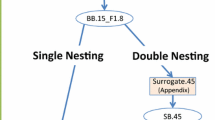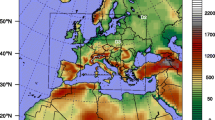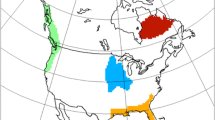Abstract
The ability of a regional climate model (RCM) to successfully reproduce the fine-scale features of a regional climate during summer is evaluated using an approach nick-named the “Big-Brother Experiment” (BBE). The BBE establishes a reference virtual-reality climate with a RCM applied on a large and high-resolution domain: this simulation is called the Big-Brother (BB) simulation. This reference simulation is then downgraded by filtering small-scale features that are unresolved in today’s global objective analyses. The resulting fields are then used as nesting data to drive the same RCM, which is integrated, at the same high resolution as the BB, only over a sub-area of the larger BB domain, hence, producing the Little-Brother simulation (LB). With the BBE approach, differences between the two simulated climates (BB and LB) can be unambiguously attributed to errors associated with the dynamical downscaling technique, and not to model errors or observational limitations. The current study focuses on the summer over the West Coast of North America. Results of the stationary and transient parts of the fields, decomposed by horizontal scales, are presented for the month of July, for 5 consecutive years (1990–1994). Three degrees of spatial filtering (roughly equivalent to the global spectral resolution of T30, T60 and T360) as well as two update intervals (3 and 6 h) of the lateral boundary conditions (LBC) have been employed. This study establishes that the maximum acceptable resolution of driving data for summer is T30, with improved results employing the T60 resolution of LBC. There is little improvement by reducing the time interval from 6 h to 3 h. These results are generally in agreement with previous studies carried out for winter. The good correlation between LB and BB simulations is more difficult to achieve during the summer season, mostly due to weaker control exerted by LBC. Poor correlations are more pronounced for the transient parts than they are for the stationary parts of the fields. This is especially true for the precipitation field, where differences can be attributed to higher temporal variability during the summer due to the presence of convection.






















Similar content being viewed by others
References
Anthes RA, KuoYH , Errico RM, Bettge TW (1985) Predictability of mesoscale motions. Advance in Geophysics, vol 288. Academic, New York, pp 159–202
Antic S, Laprise R, Denis B, de Elia R (2005) Testing the downscaling ability of a one-way nested regional climate model in regions of complex topography. Clim Dyn 25(3):473–493
Bergeron G, Laprise R, Caya D (1994) Formulation of the Mesoscale Compressible Community (MC2) Model. Internal report, Cooperative Centre for Research in Mesometeorology, Montréal, PQ, Canada, 165 pp. (Available from Dr. R. Laprise, Groupe de modélisation regional du climat, Dépatrement des sciences de la terre et de l’atmosphère, Université du Québec à Montréal, C. P. 8888, succ. Centre-ville, Montréal, Pq, H3C 3P8, Canada)
Boer GJ, Lambert JS (2001) Second-order space-time climate difference statistics. Clim Dyn 17:213–218
CAS/JSC (1998) Report of Fourteenth Session of CAS/JSC Working Group on Numerical Experimentation. Recherche en Prévision Numérique, Environnement Canada, 28 pp
CAS/JSC (1999) Report of 15th session of CAS/JSC working group on numerical experimentation. Naval Research Laboratory, 28 pp
CAS/JSC (2000) Report of 16th session of CAS/JSC working group on numerical experimentation. Bureau of Meteorology Research Center, 29 pp
CAS/JSC (2001) Report of 17th session of CAS/JSC working group on numerical experimentation. Deutscher Wetterdienst, 40 pp
Caya D, Biner S (2004) Internal variability of RCM simulations over an annual cycle. Clim Dyn 22:33–46
Caya D, Laprise R (1999) A semi-implicit semi-Lagrangian regional climate model: the Canadian RCM. Mon Weather Rev 127:341–362
Davies HC (1976) A lateral boundary formulation for multi-level prediction models. Q J R Meteor Soc 102:405–418
Davies HC, Turner RE (1977) Updating prediction models by dynamical relaxation: an examination of the technique. Q J R Meteor Soc 103:225–245
Denis B, Côté J, Laprise R (2002a) Spectral decomposition of two-dimensional atmospheric fields on limited-area domains using the discrete cosine transform (DCT). Mon Weather Rev 130:1812–1829
Denis B, Laprise R, Caya D, Côté J (2002b) Downscaling ability of one-way nested regional climate models: the big-brother experiment. Clim Dyn 18:627–646
Denis B, Laprise R, Caya D (2003) Sensitivity of a regional climate model to the resolution of the lateral boundary conditions. Clim Dyn 20:107–126
Dickinson RE, Errico RM, Giorgi F, Bates GT (1989) A regional climate model for the Western United States. Clim Change 15:383–422
Gal-Chen T, Somerville RCJ (1975) On the use of a coordinate transformation for the solution of the Navier–Stokes equations. J Comput Phys 17:209–228
Giorgi F (1990) Simulation of regional climate using a limited area model nested in a general circulation model. J Clim 3:941–963
Giorgi F, Bates GT (1989) The climatological skill of a regional model over complex terrain. Mon Weather Rev 117:2325–2347
Giorgi F, Marinucci MR (1991) Validation of a regional atmospheric model over Europe: sensitivity of wintertime and summertime simulations to selected physics parameterizations and lower boundary conditions. Q J R Meteor Soc 117:1171–1206
Giorgi F, Mearns LO (1999) Introduction to special section: regional climate modeling revisited. J Geophys Res 104:6335–6352
Jacob D, Podzun R (1997) Sensitivity studies with the regional climate model REMO. Meteorol Atmos Phys 63:119–129
Kain JS, Fritsch JM (1990) A one-dimensional entraining/detraining plume model and its application in convective parameterization. J Atmos Sci 47:2784–2802
Laprise R, Caya D, Bergeron G, Gigu M (1997) The formulation of André Robert MC2 (Mesoscale Compressible Community) model. In: Lin C, Laprise R, Ritchie H (eds) The André J. Robert Memorial Volume Atmos Ocean 35(1):195–220
Laprise R, Caya D, Giguère M, Bergeron G, Côté H, Blanchet JP, Boer GJ, McFarlen N (1998) Climate and climate change in western Canada as simulated by the Canadian regional climate model. Atmos Ocean 36:119–167
Laprise R, Caya D, Frigon A, Paquin D (2003) Current and perturbed climate as simulated by the second-generation Canadian regional climate model (CRCM-II) over northwestern North America. Clim Dyn 21:405–421
McFarlane NA, Boer GJ, Blanchet J-P, Lazare M (1992) The Canadian climate centre second-generation general circulation model and its equilibrium climate. J Clim 5:1013–1044
McGregor JL (1997) Regional climate modelling. Meteorol Atmos Phys 63:105–117
Robert A, Yakimiw E (1986) Identification and elimination of an inflow boundary computational solution in limited area model integrations. Atmos Ocean 24:369–385
Taylor KE (2001) Summarizing multiple aspects of model performance in a single diagram. J Geophys Res 106: 7183–7192
Warner TT, Peterson RA, Treadon RE (1997) A tutorial on lateral boundary conditions as a basic and potentially serious limitation to regional numerical weather prediction. BullAmer Meteorol Soc 78(11):2599–2617
Yakimiw E, Robert A (1990) Validation experiments for a nested grid-point regional forecast model. Atmos Ocean 28:466–472
Acknowledgements
This research was financially supported by the Canadian Foundation for Climate and Atmospheric Sciences (CFCAS) and the Ouranos Consortium on Regional Climatology and Adaptation to Climate Change. The assistance of the members of the Canadian Network for Regional Climate Modelling is kindly acknowledged. We also thank Mr. Claude Desrochers for maintaining a user-friendly local computing environment.
Author information
Authors and Affiliations
Corresponding author
Rights and permissions
About this article
Cite this article
Dimitrijevic, M., Laprise, R. Validation of the nesting technique in a regional climate model and sensitivity tests to the resolution of the lateral boundary conditions during summer. Climate Dynamics 25, 555–580 (2005). https://doi.org/10.1007/s00382-005-0023-6
Received:
Accepted:
Published:
Issue Date:
DOI: https://doi.org/10.1007/s00382-005-0023-6




